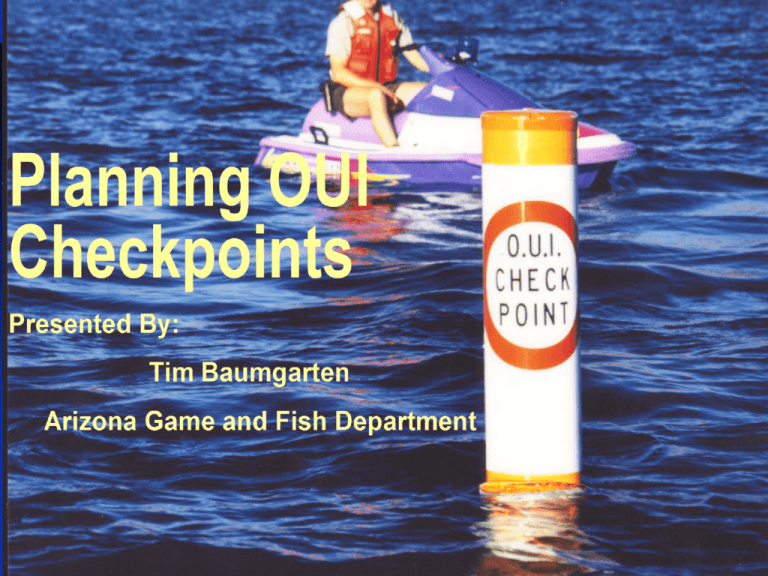OUI Checkpoints
advertisement

Checkpoints As A Tool • Detecting impaired operators – Difficult because of no lines or roadway – Sober operators drive like impaired ones • Evaluate safety equipment compliance – Compliance data cannot be based on PC stops – All operators contacted at any given location – Snapshot of education or enforcement needs • Increase public awareness • Acts as a deterrent Planning Concerns • Location – Location – Location – Safe initial contact – Primary contact area – Secondary processing area • Legal authority – Developing a Plan of Operation Safe initial contact area • Must provide notice of checkpoint • Easier to gain attention in ‘no wake’ or harbor areas • Keep distances short between initial and primary contact areas (dock) Primary contact area • Provide safe contact of operators • Accommodate approx. 60 vessels/hour • Usually need about 10 slips Secondary processing area • Seating for at least 6 subjects • Preferably shaded area • Rest areas for officers with water Evidentiary breath testing • Anti-surge hookups w/ cooling sources • Coordination of Quality Assurance procedures • Proper safe keeping of records Legal Climate • Delaware v. Prouse (1979) – Applied a balancing test » Systematic stopping procedures (No random or discretionary stops) » Public interests vs. Recreational activity » Limited intrusion (by time of contact usually < 3 minutes) » Required a planning document (removes officer discretion) Legal Climate • Florida v. Casal (1982) – Reaffirmed the public’s interest in boating safety outweighing private interests – Authorized random stops for safety inspections because no other effective means of enforcement exists Legal Climate • City of Indianapolis v. Edmond (2000) – Limited scope of checkpoints » Reaffirmed public safety interest in alcohol impairment » Secondary purposes for generalized crime control are prohibited The Plan of Operation • Guided by U.S. Supreme Court • Purpose States enforcement focus Factual basis • Minimizes Intrusion Description of systematic procedures Limited duration • Limitations of Conduct Written description of duties Addresses non-discretionary issues The Plan of Operation • General Public Notification • Notice of Approaching Checkpoint • Value added sections – Procedural Guidelines Used to address or minimize intrusions – Impounds/seizures – Personnel assignments Helps sort out witnesses later Helps assess manpower needs O.U.I. CHECKPOINT PLAN OF OPERATIONS __________(Insert Area)_____________ _______(Insert Body of Water)___ (Date) Preliminary Statement Cooperating Agencies: ___________________________________________________________, ______________________________________________________________________. Officer in charge: Operations: _____________________; Media Contacts: ___________________. Location: __________________________________________________________________, Mohave County, State of Arizona. Date: ____________ Time: ___________________________________________ Authority to conduct checkpoint: Arizona agencies' statutory authority to conduct such a project is found within Arizona Revised Statute Title 5, Section 391.B. As peace officers in the State of Arizona, with concurrent jurisdiction on (BODY OF WATER), agencies are authorized by law to enforce all statutes regarding watercraft enforcement. Pursuant to ARS §37-620.11.A., the state of Arizona recognizes the concurrent jurisdiction of Nevada by interstate compact, where mutually "prohibited conduct is committed anywhere on the boundary water between the two states". The Arizona Game and Fish Department's Mission is to provide "safe watercraft recreation for the enjoyment, appreciation, and use of present and future generations." AGFD protocol (Department Policy H1.8 and Commission Rule R12-4-308) for Wildlife Check Stations will be adapted for use on this project. History (DESCRIBE BODY OF WATER, LOCATION, RECREATIONAL ACTIVITIES WITH SUPPORTING STATISTICS.) An example is: Lake Mohave is a portion of the Colorado River located within the Lake Mead National Recreation Area, between Hoover and Davis Dams and forms state boundary waters for Nevada and Arizona. Lake Mohave is within four hours travel time from Phoenix, Las Vegas, and Los Angeles. This close proximity to these major metropolitan areas accounts for the large number of watercraft users that recreate on Lake Mohave. Lake Mohave is Arizona's second most utilized lake in terms of recreational boating. Statistics compiled by the National Park Service indicate use peaks in the month of June with approximately 150,000 visitors projected for 2002. Lake Mohave serves approximately 1.5 million visitors yearly. A recent survey OUI TASK FORCE PERSONNEL ASSIGNMENTS Contact Officers: 1. _________________ Officer in Charge: ______________________ (Secondary) ____________________ 2. _________________ 3. __________________ Media Contacts: ___________________ 4. __________________ 5. __________________ 6. __________________ 7. __________________ 8. __________________ 9. __________________ 10. _________________ 11. _________________ 12. _________________ On-The-Water Contact Officers: 1. PWC--_____________ 2. PWC--_____________ 3. PWC--_____________ 4. Contact/Chase Craft 1. __________________ Intoxilyzer Officer: _________________________









